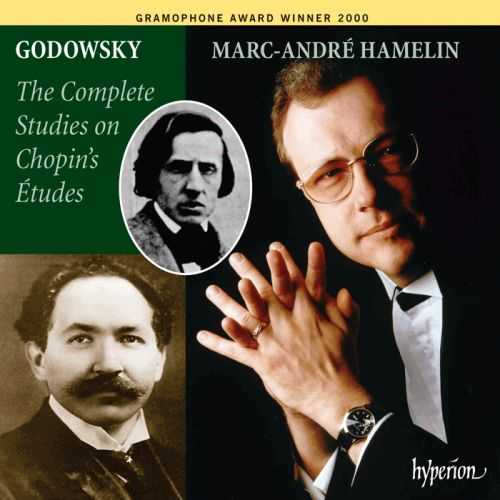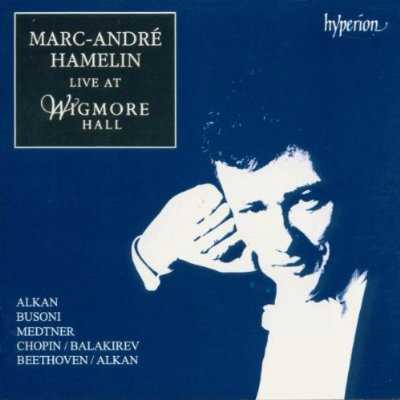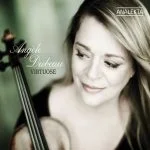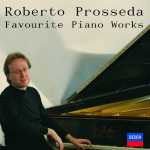
Performer: Marc-André Hamelin
Composer: Frederic Chopin
Audio CD
SPARS Code: DDD
Number of Discs: 1
Format: APE (image+cue)
Label: Hyperion
Size: 187 MB
Recovery: +3%
Scan: yes
01 Berceuse in D flat major, Op 57
Piano Sonata No.2 in B flat minor, Op 35
02 Movement 1: Grave – Doppio movimento
03 Movement 2: Scherzo
04 Movement 3: Marche funèbre
05 Movement 4: Presto
06 Nocturne in C sharp minor, Op 27 No 1
07 Nocturne in D flat major, Op 27 No 2
08 Barcarolle in F sharp major, Op 60
Piano Sonata No 3 in B minor, Op 58
09 Movement 1: Allegro maestoso
10 Movement 2: Scherzo. Molto vivace
11 Movement 3: Largo
12 Movement 4: Finale. Presto non tanto
M-A Hamelin, Chopin Sonatas 2 & 3, Piano Music: Operatic, Passionate, Infused with Bel Canto Agilità
I sent for this recording, doubtfully. I had read the four existing reviews already on Amazon. As I read it, the detractors are damning with faint praise while the fans are mainly trying to counter the detractors, writing back, No, no, he’s great.
In an atmosphere of seriously considered mixed reviews, why did I send anyway?
Well. Marc-Andre Hamelin has already gotten my attention with his many other superb releases. He has proven himself, in solo music and concertos by both, so-called off-beat composers, and by mainstream composers. The negative review comments weighed me down, yet this strong track record said: Do check out his Chopin. Having listened, I must side with the fans, for reasons I can spell out.
Right from the first track on this disc, uncommon commitment and intelligence seems to prevail. We begin with a Chopin work from the sidelines of the core Chopin oeuvre, the Berceuse. It all sounds so charming, so simple, and therein lies the trap of programming it. There are no thundering displays, as in the polonaise or the scherzo or even the impromptu. Dynamics are finely graded, on the low volume sides. Hard to make penetrating enough to reach the far walls of most modern auditoriums, hence not played all that often in live concerts. Chalk it up to Artur Rubinstein, among other gifted servants, that the Berceuse gets played at all. Hamelin plays it beautifully to my ears. He doesn’t try to make it into something other than it is, and he is compelling insofar as he reveals to me the intimate side of the composer, along with the deep and lovely indebtedness of Chopin’s melody to Bel Canto forebears (above all, Bellini, in Hamelin’s reading). Another thing I liked about having the Berceuse first is that it is not tacked on after two big Chopin sonatas, anticlimactic, disc filler.
Hamelin then launches into the first of the big sonatas, the second, opus 35.
Let me pause to confess that of all the Chopin works, I still find the sonatas challenging to appreciate and understand. Passages that sound full of genius to my ears are followed by passages that still sound harmonically disjointed, and unlike the scherzos or ballades, the composer’s allegiance to following traditional sonata forms sounds artsy and strained. In most readings, I end up thinking that Chopin would just have been better off, if he had reworked his wonderful musical materials, using something other than sonata traditions. My touchstones in the sonatas have long been the early Murray Perahia release – his first for CBS (now SONY BMG), I think. Plus the warm, poised Artur Rubinstein. Plus the very special Czech musician, Ivan Moravec. Looking at Chopin generally, I also have Michelangeli, Ohlsson, Sterczynski, Weissenberg, Argerich, Richter, Madeline Forte, and Abbey Simon on my fav shelves. Among the younger generation, Simon Trp’eski, Yundi Li, and Alexander Tharaud are keepers, no doubt. For most neglected, dark horse Chopin player, I would not hesitate to name Juana Zayas as the front running candidate. Indeed, I hear Zayas as the most neglected of the most gifted women pianists now playing in public. So, these are my markers for the sonatas, and for Chopin more widely considered.
By the end of the second sonatas, Hamelin was winning me over. Why?
To my ears – and here I probably part company with his detractors – the magical key that unlocks the doors to Hamelin’s graceful estates when it comes to playing Chopin is simply, Bel Canto. He uses his immense technical resources to tackle the second sonata as if it were a collection of scenes from a long-lost, glorious Bellini opera. This may not be the only possible way to do the second sonata, genius will out. But it surely convinces my ears and heart and mind. Keeper, then. The lack of unity I have previously heard so often in performances of the sonata are now resolved in performance. Hamelin trusts the Bel Canto insight, passionately. (His Chopin is far from clinical, then, to my ears.) The sonata changes, rung on harmony, narrative, musical context (which I have repeatedly found difficult to connect in these sonatas) now make new sense as drama and character in a Bellini-like operatic scena.
The concluding presto in the second sonata is still a mysterious musical ideal to me. I’ve read that it is supposed to be played, so that one gets the chill of horrible winds blowing across one’s grave. I can grasp that image, all right. Yet most readings I’ve heard so far fall short of this ideal, and end up sounding much more prosaic than the Gothic image. Not enough chill, not enough ghostly and ghastly supernaturalism, then.
Hamelin next does wonderful readings of two nocturnes (Opus 27) and the Barcarolle. These come off , all magic and fine. The Bel Canto keys are still opening rewarding musical gates.
Then we get to the third sonata. Like Hamelin’s Bel Canto second sonata, it all hangs together. Now Bel Canto, translated into English, is: Beautiful Song. In this third sonata the passionate lyricism trumps all. Yes, I hear clear modern touches in Hamelin’s readings. He is not that free-wheeling eccentric we can hear in Chopin playing on discs by Samson Francoise or Shura Cherkassy, for example. Again I must say that I do not find Hamelin’s remarkable restraint (given the Siren Call of his huge virtuoso baggage), nor his modern concerns for sticking to the notes, at all cool or clinical or superficial. Using the Bel Canto engagements I have mentioned, Hamelin lets the music carry him – and me as a listener – away into marvelous and beautiful and yes, free, song. He opens up immense Bel Canto vistas – all wide-screen, Technicolor Bel Canto drama – that have remained curtained off and hidden to my ears, in most recordings.
I heard this disc, first on headphones, and then on the five channel home rig. On headphones I must agree that the engineering is just good enough. Given Hamelin’s tonal palette on the modern grand piano, one glimpses that the engineers could have done an even better job of capturing Hamelin’s sound. It is perfectly service-able; yet on headphones it yields a close up, dry aspect, short on air and hall ambiance. The air that does get through makes the venue sound fuzzy, and unfocused. Would super audio high resolution have helped? Who knows?
On the home rig, music enters the room for real. So one’s listening room has a chance to redo what the recording venue as captured fails to do on this disc. The fuzzy, unfocused aspect moves farther away, and Hamelin’s Bel Canto genius takes even greater wing. Maybe mp3 for portable listening?
Contrary to other nay-sayers, then, I recommend this disc. No doubt about it, for me. Hello, keeper shelves.




thankyou so much, i hope i like his interpretations as much as i dont like the wide woman on the cover(reminds me of my ex)